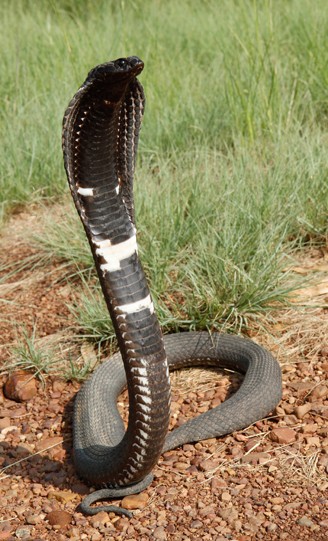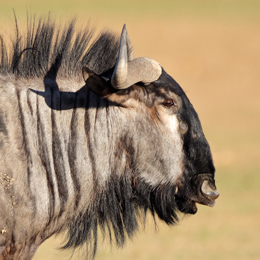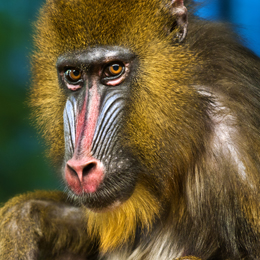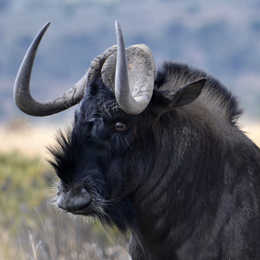Physical Description
The Rinkhals is a medium-sized snake that measures 1.2 – 1.5 m (3.9 – 4.9 ft) in length. It differs from true cobras because of the keeled dorsal scale aligned body. There are several other anatomical differences in Rinkhals that make this snake quite a unique species as compared to true cobras. The color variation of the snake depends on upon its geographical region. However, all Rinkhals display a characteristic dark belly with one or two light cross bands around the neck.
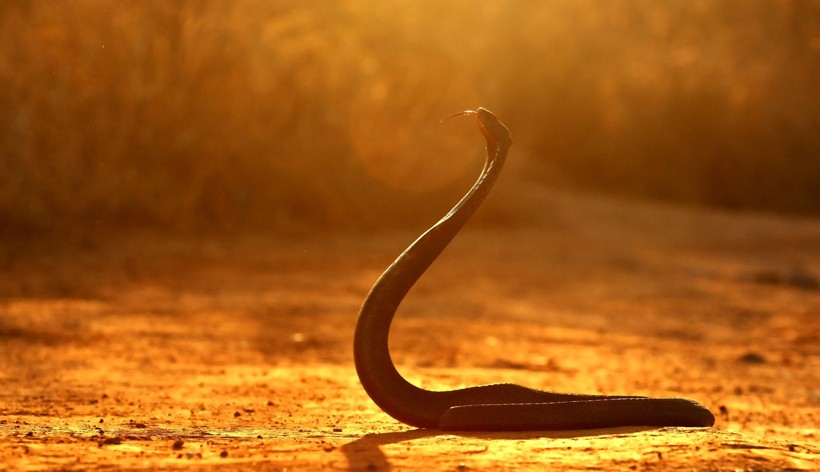
The rinkhals is a spitting cobra but has not been categorized under the true cobra genus ‘Naja’.
?
Image credits: Julian W/Shutterstock
While few individuals depict a blackish gray body, others are striped with ridged and keel like scales. Juveniles have a light gray skin tone which turns dark once they attain an average length of 1 m. In few other regions, Rinkhals displays a bright yellow or orange coloration with dark brown stripes.
Because of the presence of white cross bands around the throat, the species has been named ‘Ring-necked spitting cobra’. The species has a robust built with a short pointy head and fixed front fangs that are located only in the maxilla bone. It consists of 17 – 19 mid body dorsal scale rows, 30 – 47 sub-caudal scales and 116 – 150 ventral scales.
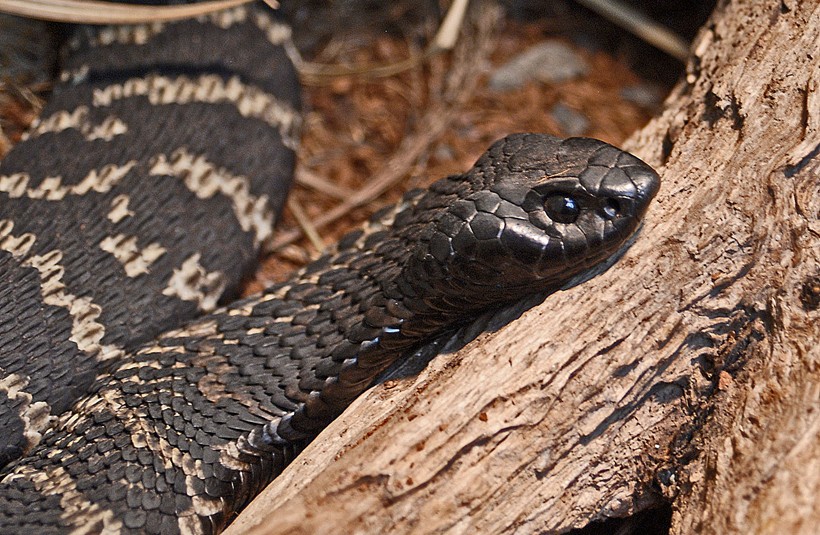
The body color of the Rinkhals helps it to camouflage in the wild which is useful during a hunt.
?
Image credits: Hectonichus/CC BY-SA 3.0
The fangs are modified in such a manner that the venom canal runs through the fang at a 90-degree bend. This elevation gives the species an ideal orientation with the exit orifice facing the front such that venom can be ejected towards an attacker’s eyes. Just like true spitting cobras, the venom ejected is in the form of geometric patterns. However, it has to rear up to do so, contrary to the true spitting cobras that can spit venom with their bodies horizontal to the ground. The anal plate is completely formed with 7 upper labial scales and 8 – 9 lower labial scales.
Habitat & Distribution
The Ringhals is an athletic looking snake that can adapt to a variety of habitats. The distribution of the species is most abundant in grasslands where there is ample rainfall. It can be found also in swamps or marshy fields, moist lowlands, wetlands and is a common occupant of Highveld regions while avoiding bushveld areas. In terms of geographical distribution, the Rinkhals is found around the eastern regions of South Africa. Its population is prominent in Southern Cape Province extending further till the northeast of Orange Free State. It is also found in Transkei, Western Swaziland and Natal. An isolated population can also be found within the central region of Inyanga across the Zimbabwe/Mozambique border.
Feeding Habits
The Ringhals feeds primarily on toads and other small mammals like squirrels, and field mice. It also consumes small reptiles like lizards and rat snakes. Juveniles tend to feed on the eggs of lizards and toads. The species doesn’t have any particular predators in the wild save for snake eating eagles, mongoose and monitor lizards. While on a hunt, the Ringhals doesn’t spit venom to attack its prey, instead it grabs onto its prey injecting a lethal dose of its cytotoxic venom. The venom is such that can cause both cytotoxic and neurotoxic effects thus leading to general paralysis and impairment of breathing.
Reproduction
Unlike true cobras, this species is ovoviviparous which means it is a live-bearing snake. The gestation period lasts for around 5 – 6 months during which the embryos develop inside the female’s oviduct. The embryo is conceptualized within a clear membrane with no egg shell where they develop until they’re ready for birth. The mating season takes place in the months of June until August and the young are born usually from late December to early March. While true cobras lay eggs, Rinkhals reproduce by giving birth to a clutch of 20 – 35 young ones, although as many as 65 newborns have been recorded also. The female tends to adopt an abandoned burrow as her nest where she gives birth to a healthy clutch of newborn Rinkhals.
There have been several cases in captive breeding of the Rinkhals where the male is said to have attacked its female mate during the mating season. This generally takes place if the male adult cannot bond with its female counterpart. Mating between Rinkhals in the wild is a particular phase where the male chooses its mate and will fight for dominance with a rival male cobra. Baby snakes born are small in size (16 – 17 cm) and generally reserve a gray-toned body with conspicuous bands all over their body. However, the characteristic white bands around the throat are quite visible at birth. There is no parental care given to the newly born ring-necked spitting cobras.
Behavior
Behavioral adaptations of Rinkhals are quite an interesting study to understand a few basic differences between the species and true cobras. There are also a few similarities between Rinkhals and true cobras especially their ability to spit venom. This is a defense mechanism that has developed to avoid attacks from dangerous predators. Like true spitting cobras, Rinkhals can also spread or flare its hood showcasing a distinctive striped neck. It can spit its venom up till 2.5 m which isn’t as far as true cobras. However, the jet sprays can cause temporary blindness. Its spitting mechanism is primitive due to which this species must rear up or fling its body forward from the ground to spit venom.
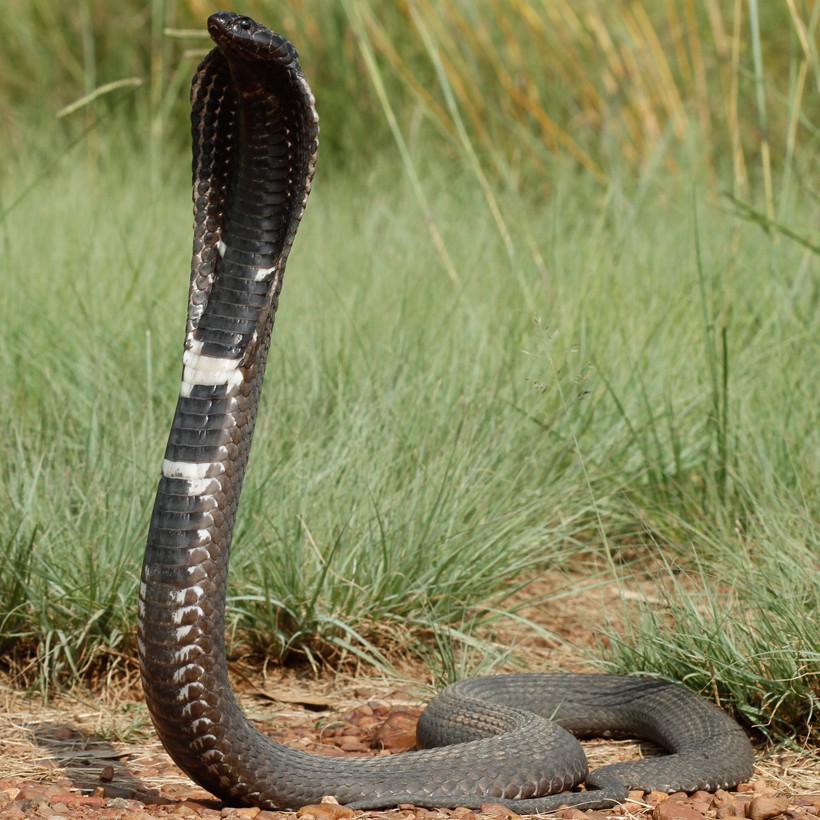
The rinkhals can spit its venom up till 2.5 m which isn’t as far as true cobras
?
Image credits: Andre Coetzer/Shutterstock
An interesting trait found in Rinkhals is that it feigns its death which makes it a very deadly predator in the wild. If the snake cannot flee and comes face to face with a predator it will roll over on its back, open its mouth with its tongue hanging out. This is a behavioral adaptation quite unlike spitting cobras of the true cobra genus that allows it to escape from any attack. The species has a tendency to attack any prey that it can consume easily which is quite similar to a ‘feeding frenzy’ often observed with other Cobras. The species is a nocturnal hunter and can often be found basking on large rocks during the day. Like true cobras Rinkhals also become territorial during the mating season. However, they are very shy unless they feel distressed or are threatened.
Venom
The venom of Rinkhals is composed of primary cytotoxins with mild neurotoxic effects. The venom of the species is thinner or slightly less viscous as compared to what is found in true cobras. This is also because a thinner fluid is easier to spit and project when facing a predator or oppressor in the wild. It is produced in a copious amount that is around 80 – 120 mg with an estimated lethal dose of 50 – 60 mg for humans. Local symptoms of a bite from the Rinkhals can generally consist of swelling, cramps, abdominal pain, nausea and vomiting. Neurotoxic effects can lead to dyspnoea and diplopea in humans but such incidents are rare.
Funfacts
- The rinkhals is also a spitting cobra but has not been categorized under the true cobra genus i.e. ‘Naja’.
- Rinkhals often feigns dead while hunting for prey
- They have a keel-like and ridged body which is an essential physical characteristic that differentiates the species from true cobras.
- They can occupy a variety of habitats being anything up to 2500 m above sea level.
- The dorsal coloration of Rinkhals, which is darkish black or gray, gives it an almost dirty appearance.
- The body color of the Rinkhals helps it to camouflage in the wild which is useful during a hunt.
